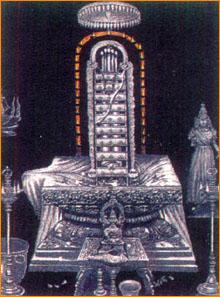Its a journey that is still on, going places, teaching me things i just dreamt of and never even thought it would come true as a burning inner desire. I have been doing television serials with the UGC, which forced me to prepare and therefore read up. These things brought me to the books. I studied for a while, for long hours on end to find a few strange discoveries.
The first for me to stumble over was the ground plan of the Elephanta caves. Stangely interesting, its a ground plan, following the buddhist cave temples at ajanta, but very strictly a yantra in design. The pillared hall forms the various points within the yantra, while the Shiva shrine and the Trimurti take up the cardinal points adding to the growing enigma that surrounds these caves.

Moving on, shaken by the discovery a little, i had to prepare for Khajuraho temples as well. I was not too keen on these Chandela temples for their well sold out erotic sculptures, but the tantric practices that surrounded them intrigued me. Shrines dedicated to the "chausat(64) yoginis" added to the haze surrounding the mother goddess cult. This turned into a fury for information as the under currents of this mother goddess cult were felt all around shiva shrines. If not for yoginis one is bound to find the sapta matrikas around shiva shrines.
Khajuraho temples ended up being more breath taking than mere erotica. After going through Devangana Desai's book on Khajuraho, it was a complete eye opener that the erotic images that arouse the delight of the non-initiated, are actually yantras or hidden geometrical patterns that protect the temples. These are grosely misunderstood to have remote connections with the kama sutra or the like. I could have shouted out to the world that moment! What they actually indicate are the various points on the composition of the erotic sculpture that behave as points on the yantras that guard the temples from evil spirits. The interesting part is that the non-initiated will never know which erotic sculpture is a yantra and which sculpture joins the batch-processing lot.
Hmm... so we close in on these mysterious diagrams which get yelled out in all these ancient shrines. Further reading confirmed that all ancient temples kept yantras in the central sanctum sanctorum of the temples dedicated to the divinity being housed there and a ritual is performed with respect to the ruling king's "gotram" and "nakshatram". After this, interestingly, his angula or finger is used as the basic system of measurement for the temple construction. (will give more dope on that in another post).
But well lets come back to these geometrical patterns. A diagram, housing a syllable, sounds like nothing to the un-initiated but means a whole new world to someone well versed with it, or trying to know it at least. A single bija mantra at the bindu or center, and that is the summary of potency well beyond our imagination. Its a crazy world beyond logic as we understand it. It could be chance, it could be an equation of which i still have not managed to understand anything, but i know it certainly works.
Yantras are to be understood, to be felt, to be respected and worshipped. They are not toys for a greater future, with an easier life, more wealth, better health etc. Yes, those things will come in, but its interesting to see how the recital of a mantra, sitting on a grass mat, with a yantra in a brass plate with a few offerings and an oil lamp can make all the difference. It requires persistence and complete dedication.
Truely amazing. I can tell you this much, most people stop with faith to a certain extent, but getting into the depths of it is a challenge. Its about putting yourself on the line to find out and see the result which might not necessarily be as expected, but is an enlightenment anyway. Its about risk, into the unknown world, where things can go really well or drastically wrong and all that you cling onto is love and faith. Yantras wake you out of mundane reality, uplift you from a suffering called life and make you look at problems as if they are nothing.
Its a world which you enter just once and never leave. Its what lies just beyond human ignorance.



